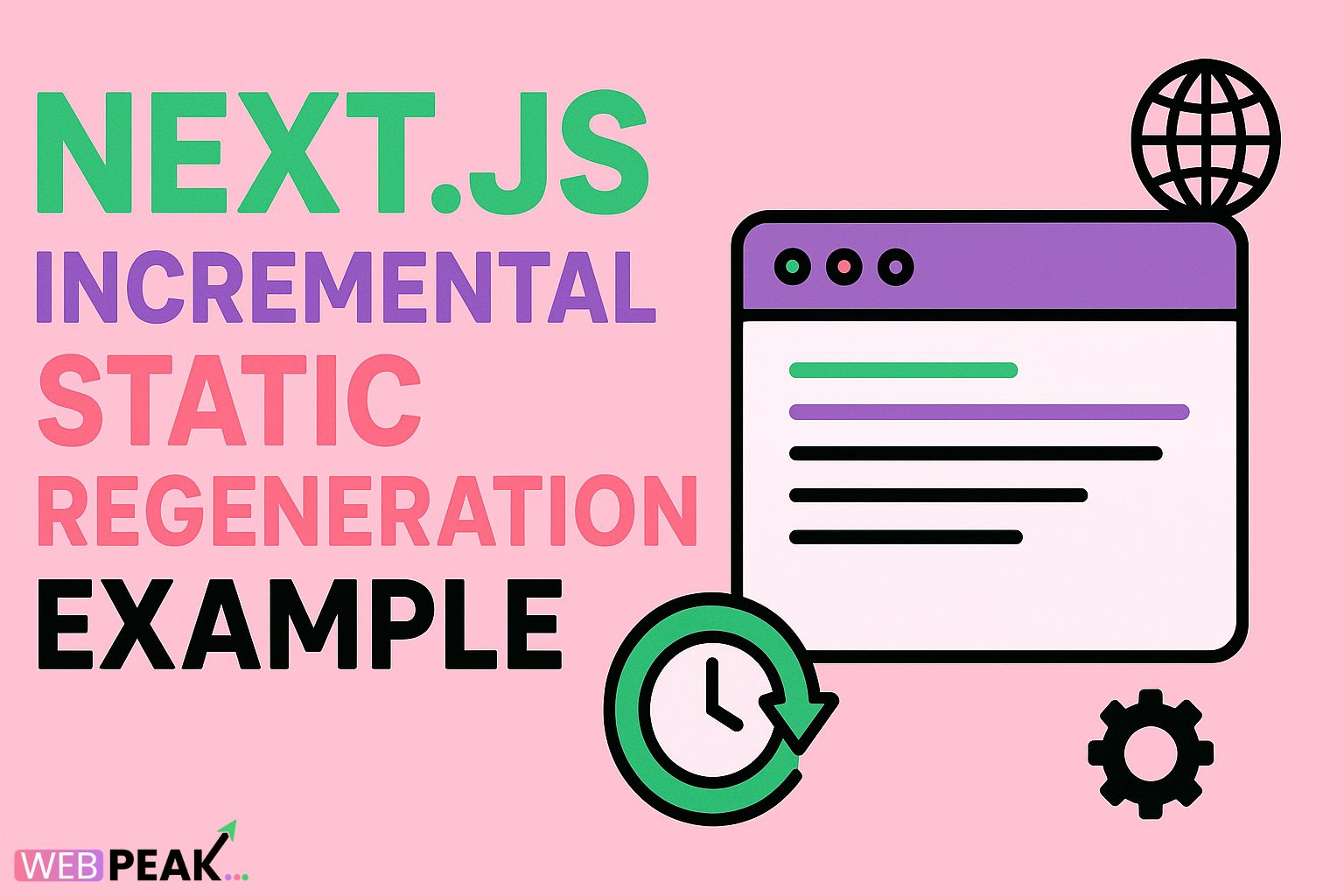Next.js Incremental Static Regeneration Example
If you’ve ever wondered how to combine the speed of static site generation with the flexibility of server-side rendering, then understanding Next.js Incremental Static Regeneration (ISR) is essential. In this comprehensive guide, we’ll explore what ISR is, why it’s a game-changer for developers, and provide a complete Next.js Incremental Static Regeneration example to help you implement it easily. By the end, you’ll know exactly how to build fast, scalable, and SEO-friendly web applications using ISR.
What is Incremental Static Regeneration (ISR) in Next.js?
Incremental Static Regeneration (ISR) is a feature in Next.js that allows developers to update static pages after they’ve been built and deployed. Traditionally, static site generation (SSG) builds all pages at once during deployment. However, this can become slow and inflexible as your site grows.
ISR bridges this gap by letting you regenerate specific static pages on-demand, without rebuilding the entire site. This means you can have the best of both worlds: blazing-fast static performance and the ability to update content dynamically.
How ISR Works in Next.js
With ISR, you specify a revalidate time in seconds within your page’s getStaticProps function. When a user visits the page, Next.js serves the cached static page. Once the revalidation time expires, the next request triggers a regeneration in the background. After regeneration, all future users receive the updated version automatically.
Example Flow of ISR:
- Initial request: A static HTML page is served instantly.
- After the revalidation period, the next request triggers regeneration.
- The page updates in the background while users continue to see the cached version.
- When regeneration finishes, Next.js replaces the old static page with the new one.
Why Use Incremental Static Regeneration?
ISR offers an ideal solution for websites that require frequent updates but still want to maintain the benefits of static generation. Here’s why developers and SEO experts love it:
- Improved Performance: Pages load lightning-fast because they’re pre-rendered as static HTML.
- SEO-Friendly: Search engines can easily crawl pre-rendered pages, improving rankings.
- Dynamic Updates: You can update only specific pages without rebuilding the entire site.
- Reduced Build Time: ISR minimizes deployment time by avoiding full site regeneration.
- Better Scalability: Ideal for eCommerce stores, blogs, or large dynamic sites with thousands of pages.
Next.js Incremental Static Regeneration Example
Let’s look at a practical example of how to implement ISR in a Next.js project. This step-by-step guide will walk you through creating a simple blog page that uses ISR to regenerate content every 60 seconds.
1. Create a New Next.js Project
npx create-next-app nextjs-isr-example
cd nextjs-isr-example
npm run dev
2. Create a Sample Data Source
For demonstration, let’s use a simple JavaScript object as our data source. In a real-world application, this could be fetched from an external API or a headless CMS.
// data/posts.js
export const posts = [
{ id: 1, title: 'Next.js ISR Guide', content: 'Learn how ISR works in Next.js.' },
{ id: 2, title: 'Optimizing SEO with ISR', content: 'Boost SEO using static regeneration.' },
];
3. Build a Page with getStaticProps
Use getStaticProps to pre-render the page and include the revalidate key to define the regeneration time.
// pages/index.js
import { posts } from '../data/posts';
export async function getStaticProps() {
return {
props: {
posts,
time: new Date().toISOString(),
},
revalidate: 60, // Regenerate page every 60 seconds
};
}
export default function Home({ posts, time }) {
return (
<div>
<h1>Next.js Incremental Static Regeneration Example</h1>
<p>Last updated: {time}</p>
<ul>
{posts.map(post => (
<li key={post.id}>
<h2>{post.title}</h2>
<p>{post.content}</p>
</li>
))}
</ul>
</div>
);
}
4. Test ISR Functionality
Run your app and open it in the browser. Each time the revalidate interval passes, refresh the page to see the “Last updated” timestamp change — proof that your page regenerated automatically in the background.
Best Practices for Using ISR
- Use appropriate revalidation intervals. Choose intervals based on how often your content changes.
- Combine ISR with fallback pages for dynamic routes to handle new content gracefully.
- Monitor build and regeneration logs to ensure pages update as expected.
- Integrate ISR with a headless CMS like Strapi, Sanity, or Contentful for scalable content updates.
- Leverage on-demand revalidation (Next.js 12+) to refresh specific pages programmatically after content updates.
On-Demand ISR with Next.js API Routes
You can trigger regeneration manually using API routes. This is especially helpful when content changes in a CMS, and you want to update specific pages instantly instead of waiting for the revalidation timer.
// pages/api/revalidate.js
export default async function handler(req, res) {
try {
await res.revalidate('/'); // Regenerate the home page
return res.json({ revalidated: true });
} catch (err) {
return res.status(500).send('Error revalidating');
}
}
SEO Benefits of Next.js Incremental Static Regeneration
ISR plays a vital role in improving your website’s SEO performance. Since ISR delivers pre-rendered pages, search engines like Google can index them effectively. The regeneration feature ensures that your pages always stay up to date without sacrificing crawl efficiency.
- Fast load times: Pages are served as static HTML for better Core Web Vitals.
- Fresh content: Automatically keeps your site updated for improved search rankings.
- Consistent metadata: Dynamic regeneration allows your meta tags and structured data to remain current.
- Reduced downtime: ISR updates happen seamlessly in the background.
SEO Checklist for ISR Implementation
- Ensure your pages include meta titles and descriptions.
- Use semantic HTML tags for improved crawlability.
- Implement canonical URLs to avoid duplicate content.
- Include an XML sitemap and submit it to Google Search Console.
- Regularly test page speed with Lighthouse or PageSpeed Insights.
- Enable structured data for rich search snippets.
Common Mistakes to Avoid with ISR
- Using a revalidate time that’s too short, causing unnecessary server load.
- Forgetting to handle errors in revalidation logic.
- Not testing fallback states for new pages.
- Over-relying on ISR instead of caching or API optimization.
FAQ: Next.js Incremental Static Regeneration
1. What is the difference between ISR and SSR?
ISR pre-renders pages at build time and regenerates them periodically, while SSR renders pages on every request. ISR provides better performance and scalability.
2. Can ISR work with dynamic routes?
Yes. You can use ISR with dynamic routes using getStaticPaths and fallback options like blocking or true.
3. How do I trigger ISR manually?
You can trigger revalidation programmatically using the res.revalidate() function in an API route, allowing on-demand regeneration.
4. Is ISR good for SEO?
Absolutely. ISR combines static speed with fresh content delivery, improving crawl rates, indexation, and overall SEO performance.
5. Does ISR require a specific hosting platform?
ISR works seamlessly on Vercel (the creators of Next.js) but can also be configured on other Node.js-compatible hosting providers with proper caching setup.
Conclusion
Next.js Incremental Static Regeneration revolutionizes how modern web applications handle static and dynamic content. It gives developers the ability to update static pages instantly without rebuilding the entire site—combining performance, scalability, and SEO in one package.
If you want to take your Next.js projects to the next level or need professional support with SEO, web development, or digital marketing, consider working with WEBPEAK— a full-service digital marketing company specializing in modern web solutions.





